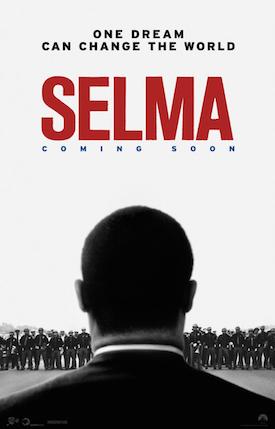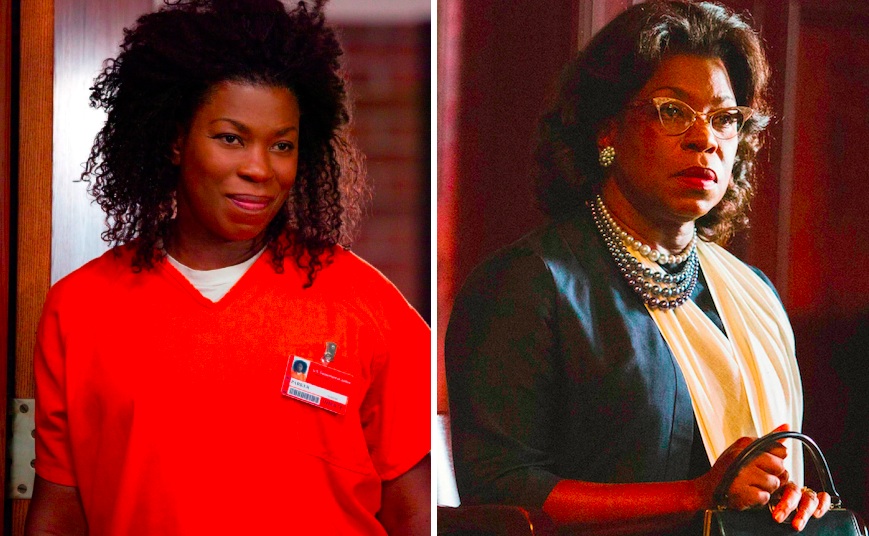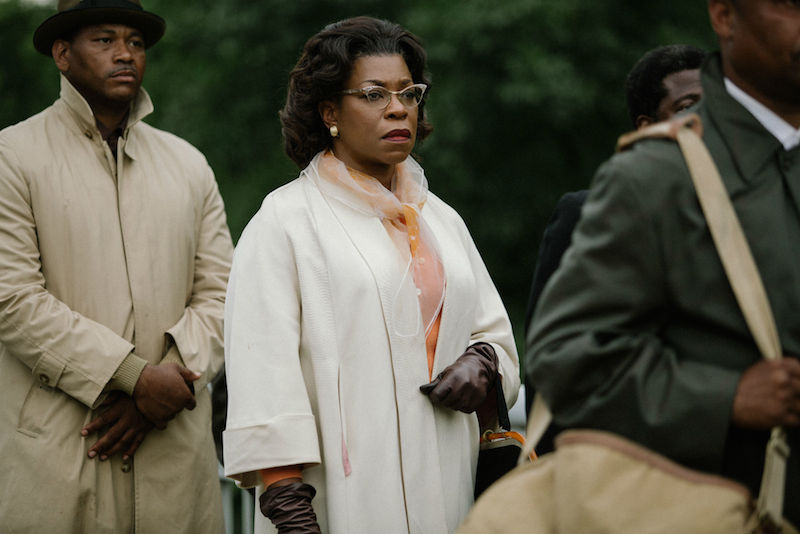 Ava DuVernay’s stunning film Selma recounts the epic 1965 march from Selma to Montgomery to help secure equal voting rights for African Americans. The film features superb performances by David Oyelowo as Martin Luther King, Jr., and Carmen Ejogo as Coretta Scott King. We see many of the national players of the civil rights movement as well as other historic figures such as President Lyndon B. Johnson (Tom Wilkinson) and Governor George Wallace (Tim Roth). But it’s just as exciting to see the lesser-known characters, actual residents of Selma and neighboring communities, without whom the groundwork would never have been laid for King’s historic visit. The incredibly talented cast of Selma includes Oprah Winfrey, Common, Cuba Gooding, Jr., Giovanni Ribisi, Dylan Baker, Tessa Thompson, and, in the pivotal role of local civil rights activist Amelia Boynton, Lorraine Toussaint. It was Boynton who got King to come to Selma in the first place. After enduring so much in the struggle for civil rights, Amelia Boynton was eventually invited to the White House to be present when President Johnson signed the Voting Rights Act into law.
Ava DuVernay’s stunning film Selma recounts the epic 1965 march from Selma to Montgomery to help secure equal voting rights for African Americans. The film features superb performances by David Oyelowo as Martin Luther King, Jr., and Carmen Ejogo as Coretta Scott King. We see many of the national players of the civil rights movement as well as other historic figures such as President Lyndon B. Johnson (Tom Wilkinson) and Governor George Wallace (Tim Roth). But it’s just as exciting to see the lesser-known characters, actual residents of Selma and neighboring communities, without whom the groundwork would never have been laid for King’s historic visit. The incredibly talented cast of Selma includes Oprah Winfrey, Common, Cuba Gooding, Jr., Giovanni Ribisi, Dylan Baker, Tessa Thompson, and, in the pivotal role of local civil rights activist Amelia Boynton, Lorraine Toussaint. It was Boynton who got King to come to Selma in the first place. After enduring so much in the struggle for civil rights, Amelia Boynton was eventually invited to the White House to be present when President Johnson signed the Voting Rights Act into law.
Having just seen her chilling performance as Yvonne “Vee” Parker in the second season of the Netflix series Orange Is the New Black, I was thrilled to participate in a small roundtable discussion with Lorraine Toussaint about this film and talk to her about her journey from Vee’s utter darkness to Amelia’s great light. I told her that after watching her performance in Selma, I would like to see a whole film centered on her character.
Lorraine Toussaint: That’s interesting. I was watching the movie last night and was thinking about some pivotal scenes of mine that were cut and would have really bookeneded her in a better way. I do think she’s worthy of her own film. She’s the person who invited Martin to Selma. And she is the one who almost single-handedly had been prepping this community for years. Relentlessly registering people, relentlessly holding secret night classes, quietly building up the pressure in the community. Resisting, getting arrested, marching. By the time you meet her in the film she’d been arrested countless times — she’d been harassed and beaten up, and when Martin finally comes in, she knows the whole situation is ready to blow. She knows that Martin’s presence is going to be the thing that tips it. And in that tipping is going to be that very small window of change. She was very, very smart.
What kind of research did you to do get ready to play her?
You know, everyone came together around Ava (DuVernay) because that’s what Ava does. We all had a kind of selfless commitment to the work, where it’s almost like, “Don’t look at me, just look at what I’m putting into the pot.” Ava also attracted the real-life people. So Andy Young showed up on set, and John Lewis showed up. We would literally be sitting on the floor at their feet, listening to them talk about what it was like to be twentysomething and changing the world with Martin. They told us what it was like when no one was looking. And they talked about Miss Amelia. She was a schoolteacher back then. They were mostly in their twenties and she was about 50, so she was like the den mother. I read her autobiography, I looked at photos of her, and I got to listen to a lot of recordings of her speeches and appearances. What did we ever do before YouTube was around?
I also did a lot of research on the period. As a modern woman, there are certain things that I take for granted. It shows up in the way I sit, the way I walk, the way I think, what I know to be possible, and so I had to systematically subtract that and put it to the side and see what’s left. You had to pare way down and then empower that.
And you got to meet the real Amelia Boynton?
Yes, I did! She’s 103 now and has seen the world change in so many extraordinary ways. It was very humbling to meet her, I was quite star-struck. I thought I would ask her all these important questions but we ended up talking about recipes and gardening — anything she wanted to talk about was fine by me, it was more about being in her presence. There is a real responsibility when you’re playing a real character to honor that person. You want to somehow receive permission through osmosis, to receive inspiration from that person. They need to sort of anoint you in some way that allows you, like Native Americans say, to “steal” or “borrow” a small piece of their soul. So when I was in her presence, I was very moved to feel that transference from her to me.
It’s a tribute to your performance that even though your screen time is not that long, we really feel the importance of this character.
Thank you. She was a quiet presence there and she brought Martin in to do what Martin does best. This was her community, these were her people. When her husband died, who was also an activist, it was one of the few times when all of the black people did not go to work that day and went to his funeral en masse. The price of that was extraordinary in that community. That’s how much they were loved. So then to take a back seat to Martin because she knew that he was the one who was going to do what needed to be done, that took a great deal of humility. In many ways, that’s what we all did in this film, we all were clearly and actively in service to this piece of work.
Many people who see this will remember your recent performance as Vee in Orange Is the New Black. What is it like to go from such a beacon of darkness to this incredible beacon of light?
(Long pause.) I’ll give you the real answer. The light and the dark are the same. They rub up against each other and they are extraordinarily familiar with each other. So it’s not difficult for me to move from one to the other — they’re actually intimate friends.
Wow, that’s a fascinating answer.
That’s the real answer. You looked like you could handle it (Laughs.)
The material in this film is so important. Do you feel working on it changed you in any way?
You know, when we were making this film, I had to put that idea aside. When you’re standing on that bridge and looking down into those muddy waters below, and you KNOW there are bones down there, I mean, it’s hard to be aware of the importance of this moment in history. But you can’t play history, you can’t play historical characters or moments — you just have to reduce it to the ordinary because the ordinary is ultimately what moves us most deeply, it is what touches us. I did take my ten-year-old daughter, Samara, with me. I didn’t want her to learn about the civil rights movement just from books, so I pulled her out of school for two months and said, “Come walk where Martin walked, come stand on that bridge, come meet some of these characters as we bring them to life.” At night we read books like Selma, Lord, Selma that talked about the events from a child’s perspective. So maybe that experience changed my daughter’s life in some way.
Did she get to be in the film?
Yes, she was an extra and was oh so pleased! When I first saw the film I thought, “Oh, thank God, she’s still in it!”
Many young won’t be familiar with a lot of these characters. What do you hope they take away from the film?
I think so many young people today feel powerless. We live in a world where they might think their contribution doesn’t matter. When I look at the characters in this film, I’m struck by how young they were. And yet they changed the world. They lobbied around a cause that they were willing to die for. I’ve always envied the civil rights era because I think it was the last time in American history where there was a moment where many people were willing to lay down their lives for something they believed in. Short of my daughter, I’m not sure I would be willing to lay my life down for an idea. I would like to hope that there are young people that will look at this film and think, “My God, they are so young, look what they did! Is there something that is important enough in my life to really fight for? Something to stick with and question?” With my own daughter, I keep insisting, often to my own detriment, that she question authority. Sometimes we’ll be watching TV and I’ll say, “What are you watching there, Samara?” “A commercial.” “And what are commercials?” “They are a source of evil.” (Laughs.) “That’s correct!” Many young people are asleep. We’ve found many ways to dumb people down, to be numb. I hope that this film touches young people and helps them begin to awaken.


